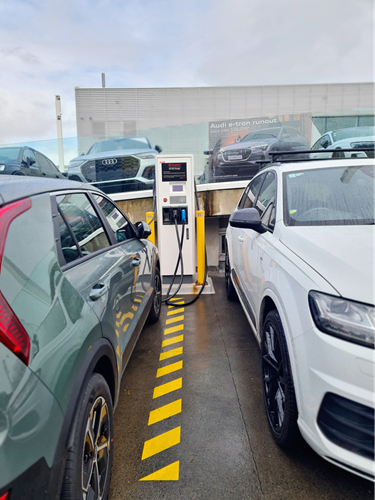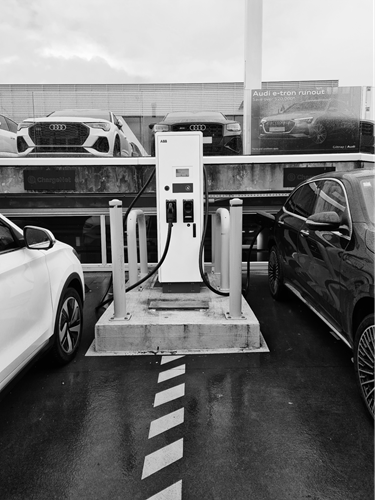Debbie Ward, the National Leadership Coordinator at CCS Disability Action, lives with a disability. She says that electric vehicles are an easy example of how climate change prevention excludes disabled people.
“I dread the challenges that I am going to encounter in even being able to charge an e-vehicle at home and when I’m out in the community.”
Ward says that e-charging stations are frequently inaccessible for disabled people, especially for those who use wheelchairs or who have other mobility impairments. This is because charging stations are frequently situated higher on the pavement with no kerb-cut access and certain stations have protective bollards or wheel stops in front of them.
Both of these elements make it challenging for someone in a wheelchair or who has mobility impairments from being able to access the charging cable and the payment screen.
Ward also says that many e-charging stations are located in standard-sized car parking bays, which means that it can be difficult for a mobility aid user to safely unload from their vehicle in the first place.

The New Zealand access standard (NZS 4121) says that the standard size for an off-street accessible park is 3.5m x 5m. The 4121 standard also says that ticket dispensers or other devices should be placed at a height of 1.1m and no more than 20 cm horizontally behind a kerb.
This is important, because there are e-charging stations that are situated in standard-sized car park spaces (2.5 m x 5 m) and the station is placed too far back from the kerb (as seen in the photograph below). Both of these factors can prevent a wheelchair user or someone with mobility impairments from being able to successfully reach the machine.
CCS Disability Action Policy Analyst Phoebe Eden-Mann says that the disabled community needs to be engaged at every part of the policy-making process, especially for policies that relate to the “climate crisis on our doorstep.”
She says the lack of consultation was evident during the development of the e-vehicle charging strategy. In the Charging Our Future: Discussion document, New Zealand’s long-term strategic vision for our national electric vehicle charging infrastructure, disability is only mentioned once.
Under Focus area 2b. of the discussion document, there is a request for feedback on the following question - “Are there any actions needed to reflect the particular EV charging needs of disabled communities, Maori, or other groups?”
Eden-Mann says that it was “quite alarming” that a well-thought out strategy for the future of New Zealand’s transport could forget about the disabled community. With the exception of that singular question about how minority groups might need to be considered.
Ward says that the disability community is not being given the opportunity to be involved during the decision-making process, which means that their “unique perspectives” are not being considered. This is despite the fact that rolling out electric vehicles on a greater scale without addressing accessibility issues could prevent disabled drivers from being able to get around the community independently.
Eden-Mann highlighted that there is an international policy precedent that our government could learn from.
In 2022, the British Standards Institution (BSI) launched the new accessibility standard for the design of public electric vehicle charging infrastructure. This covered aspects such as the location, spacing, and placement of charge points in their physical environment. More importantly, it specifies the factors that need to be included in accessible charging station design (charge point height, bollard spacing, cables or cable management systems, colours used on screens, weight and ease of equipment to use).
However, the New Zealand strategy does not mention any of the identified access problems with e-charging stations.
“This is absolutely absurd, why are we making the exact same mistakes that other countries before us have made when we have the opportunity to do it better?” says Eden-Mann.

Another concern that Ward raised is whether electric vehicles can be suitably modified to accommodate the needs of disabled people when the time comes to ditch petrol vehicles altogether.
Milner Mobility General Manager Darren Milner says that there is minimal availability of electric vehicles that are suitable for disability modifications, especially for clients who require adaptations to accommodate a wheelchair.
“It’s going to be a slow process, because it’s not currently technologically possible [to adapt the majority of electric vehicles],” says Milner.
As a result, Milner Mobility is forced to mostly import vehicles that still run on fossil fuels. Due to Aotearoa’s Clean Car Standard, the import charges associated with vehicles that exceed target emissions mean that Milner’s disabled clients face additional costs of between $1000-$2000 when purchasing their modified vehicle.
The Ombudsman’s summary report, Disability Rights: How is New Zealand doing?, notes that disabled people are overrepresented in all poverty-related statistics. It states that on average, disabled people have significantly lower incomes than non-disabled people, whilst also experiencing increased disability-related costs. Therefore the burden of additional costs to vehicle modification will be felt strongly by the disabled community.
Ward is justifiably concerned.
“I don’t know what it’s going to take for things to change, other than actually including the voice of disabled people.”
The acting Transport Minister Kieran McAnulty was approached for this story, but he declined to comment.


